
The William Cullen Bryant Homestead is the boyhood home and later summer residence of William Cullen Bryant (1794–1878), one of America's foremost poets and newspaper editors. The 155-acre (63 ha) estate is located at 205 Bryant Road in Cummington, Massachusetts, overlooks the Westfield River Valley and is currently operated by the non-profit Trustees of Reservations. It is open to the public on weekends in summer and early fall for tours with an admission fee.

Academy Building is a historic building in Fall River, Massachusetts. The building was constructed in 1875 as a memorial to Nathaniel Briggs Borden by his family. It opened its doors on January 6, 1876. It was added to the National Register of Historic Places in 1973.

Al Mac's Diner-Restaurant is an historic restaurant building at 135 President Avenue in Fall River, Massachusetts. It is an example of the stainless steel diners in Massachusetts, with rectangular massing, a flat roof, a projecting center entry vestibule, and rear kitchen wing.
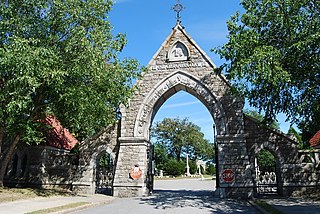
Oak Grove Cemetery is a historic cemetery located at 765 Prospect Street in Fall River, Massachusetts. It was established in 1855 and greatly improved upon in the years that followed. It features Gothic Revival elements, including an elaborate entrance arch constructed of locally quarried Fall River granite. The cemetery originally contained 47 acres, but has since been expanded to over 120 acres. The cemetery is the city's most significant, built in the planned rural-garden style of Mount Auburn Cemetery in Cambridge, Massachusetts. It was designed and laid out by local architect Josiah Brown, who is also known for his designs of early mills including the Union, Border City, and others.

The Metacomet Mill, built in 1847 by Colonel Richard Borden for the manufacture of cotton textiles, is the oldest remaining textile mill in Fall River, Massachusetts.

The Lower Highlands Historic District encompasses one of the oldest residential areas of Fall River, Massachusetts. The district is roughly bounded by Cherry, Main, Winter, and Bank Streets, and is located just east of the Downtown Fall River Historic District and directly south of the Highlands Historic District. This area was settled by 1810, has architecture tracing the city's growth as a major industrial center. The historic district was added to the National Register of Historic Places in 1984.
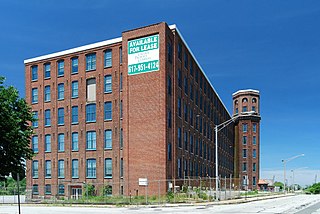
Mechanics Mill is an historic cotton textile mill located at 1082 Davol Street in Fall River, Massachusetts.

The Valentine–French House is a historic house located at 5105 North Main Street in Fall River, Massachusetts.

Corky Row Historic District is a historic district located in Fall River, Massachusetts bounded by Plymouth Avenue, Interstate-195 and Second Street. The district contains many early multi-family mill tenement houses, along with the Davol Mills, the Tecumseh Mill No. 1 and several commercial properties.

Davol School is a historic school at 112 Flint Street in Fall River, Massachusetts. It was built in 1892 and added to the National Register of Historic Places in 1983. The eight room elementary schoolhouse was designed by notable city architect Joseph M. Darling, on the same plan as Connell School located on Plymouth Avenue. The brick Romanesque Revival structure is two stories in height, with a projecting entry section that is topped by a square tower with an open belfry and pyramidal roof. The school was built during a major expansion of the school system, increasing the number of classrooms by 20%.
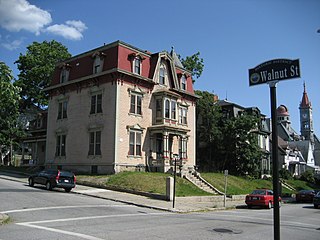
The Highlands Historic District is a historic district roughly bounded by June, Cherry, and Weetamoe Streets, Lincoln, Highland, President, North Main, and Hood Avenues in Fall River, Massachusetts. The district lies just north of the Lower Highlands Historic District.

William M. Connell School is a historic school located at 650 Plymouth Avenue in Fall River, Massachusetts. It was built in 1893 and added to the National Register of Historic Places in 1983. It was designed by notable city architect Joseph M. Darling on the same plan as the Davol School. The school is named after William Connell, who served as the city's Superintendent of Schools from 1872 to 1894.
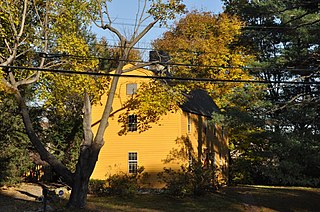
The Capt. William Green House is a historic colonial house at 391 Vernon Street in Wakefield, Massachusetts. It is one of Wakefield's oldest surviving buildings. The house was listed on the National Register of Historic Places as part of two separate listings. In 1989 it was listed under the name "Capt. William Green House", and in 1990 it was listed under the name "Green House".
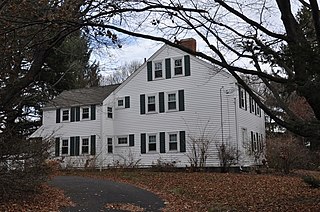
The Jonas Cowdry House is a historic house at 61 Prospect Street in Wakefield, Massachusetts. Built c. 1833, the Federal style wood-frame house is three bays wide and four deep, a significant local variant to conventional Federal style architecture. The house was listed on the National Register of Historic Places in 1989.

Hartwell & Swasey was a short-lived 19th-century architectural firm in Boston, Massachusetts. The partnership between Henry Walker Hartwell (1833-1919) and Albert E. Swasey, Jr. lasted from the late-1860s to 1877, when Swasey went on his own. In 1881, Hartwell formed a partnership with William Cummings Richardson – Hartwell and Richardson – that lasted until his death.

Josiah Brown (1816–1875) was an American architect and civil and mill engineer of Fall River, Massachusetts. Among his major surviving projects are the Union Mill No. 1 (1859) and Border City Mill No. 2 (1873), both in Fall River.

Springside Park is a recreational city park on the north side of Pittsfield, Massachusetts. At 237.5 acres (96.1 ha) it is the city's largest park. Much of the park is wooded, providing for passive recreational opportunities such as hiking. The southwestern section of the park, nearest to North Street, is developed, with ballfields, a bath house, pond, and Springside House, an Italianate mansion whose early construction dates to c. 1856. Some of the parklands are also used for the Hebert Arboretum. Through the 1960s the City of Pittsfield operated a ski rope tow and provided ski lessons at the park. The park was listed on the National Register of Historic Places in 2008.

Davol Mills is a historic textile mill complex located at the corner of Plymouth Avenue and Rodman Street in Fall River, Massachusetts. It was built in 1867 and expanded in 1871. It was added to the National Register of Historic Places in 1983 as part of the Corky Row Historic District The red brick mills are unique in the city, built in the Second Empire style.

Tecumseh Mill No. 1 is a historic cotton mill located at 164 Hartwell Street in Fall River, Massachusetts. It was built in 1866, and added to the National Register of Historic Places in 1983 as part of the Corky Row Historic District. Tecumseh Mills No. 2 and No. 3 were located nearby on Plymouth Avenue, but have since been demolished.

The William Peabody House is a historic house on North River Road in Milford, New Hampshire. This 2+1⁄2-story wood-frame house was built c. 1740 by William Peabody, the first English settler of the Milford area, and remains a good example of Georgian residential architecture despite a 1973 fire. The house was listed on the National Register of Historic Places in 1979.






















